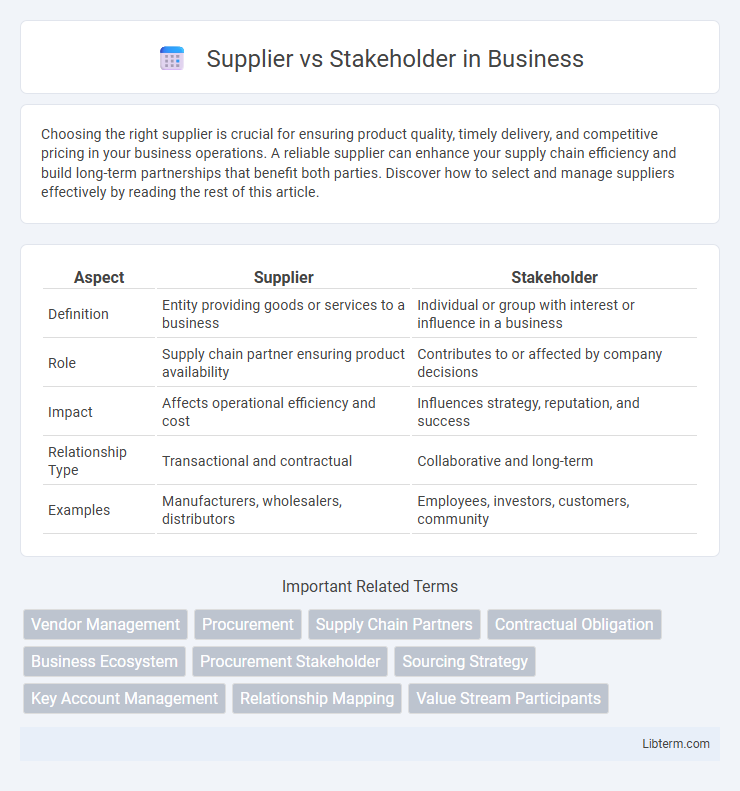Choosing the right supplier is crucial for ensuring product quality, timely delivery, and competitive pricing in your business operations. A reliable supplier can enhance your supply chain efficiency and build long-term partnerships that benefit both parties. Discover how to select and manage suppliers effectively by reading the rest of this article.
Table of Comparison
| Aspect | Supplier | Stakeholder |
|---|---|---|
| Definition | Entity providing goods or services to a business | Individual or group with interest or influence in a business |
| Role | Supply chain partner ensuring product availability | Contributes to or affected by company decisions |
| Impact | Affects operational efficiency and cost | Influences strategy, reputation, and success |
| Relationship Type | Transactional and contractual | Collaborative and long-term |
| Examples | Manufacturers, wholesalers, distributors | Employees, investors, customers, community |
Introduction: Understanding Suppliers and Stakeholders
Suppliers provide essential goods or services that enable a company's operations, directly impacting production quality and cost efficiency. Stakeholders encompass a broader group, including employees, investors, customers, and suppliers, each with varying interests in the organization's performance. Distinguishing between suppliers as external contributors and stakeholders as entities with vested interests is crucial for effective business strategy and relationship management.
Defining Suppliers in Business Context
Suppliers are entities or individuals that provide essential goods, services, or raw materials required for a company's production processes or operations. They play a critical role in the supply chain by ensuring the availability and quality of inputs, directly impacting business efficiency and customer satisfaction. Unlike stakeholders, whose interests may be varied and indirect, suppliers have a direct transactional relationship with the business focused on exchanging value through goods or services.
Who Are Stakeholders?
Stakeholders are individuals or groups directly or indirectly affected by a company's actions, decisions, and policies, including employees, customers, investors, suppliers, and community members. Unlike suppliers who primarily provide goods or services to the organization, stakeholders encompass a broader range of interests and influence organizational outcomes through their varying levels of involvement. Understanding stakeholder roles is crucial for effective communication, risk management, and long-term business sustainability.
Key Differences Between Suppliers and Stakeholders
Suppliers provide goods or services essential for a company's operations, focusing on transactional relationships and supply chain management. Stakeholders encompass a broader group including employees, customers, investors, and communities, all holding varying degrees of interest and influence over the organization's strategic decisions. The key difference lies in suppliers' role in operational input versus stakeholders' role in shaping overall business objectives and sustainability.
Roles and Responsibilities of Suppliers
Suppliers play a critical role in the supply chain by providing goods, services, and raw materials essential for business operations and product development. Their responsibilities include ensuring timely delivery, maintaining quality standards, and adhering to contractual agreements to support production schedules and customer satisfaction. Effective supplier management involves performance monitoring, risk assessment, and collaboration to drive cost efficiency and innovation.
Stakeholder Influence on Business Decisions
Stakeholders wield significant influence on business decisions by shaping company policies, driving strategic priorities, and allocating resources based on their interests and concerns. Their diverse roles include investors demanding financial performance, customers requiring product quality, and employees seeking favorable working conditions, all directly impacting operational and financial outcomes. Effective stakeholder engagement enhances decision-making transparency, aligns corporate goals with market expectations, and fosters sustainable business growth.
Supplier Relationship Management
Supplier Relationship Management (SRM) emphasizes strategic collaboration with suppliers to optimize procurement processes, reduce costs, and ensure quality delivery, distinguishing suppliers as external entities directly providing goods or services. Stakeholders encompass a broader group, including suppliers, employees, customers, and investors, all influencing or impacted by organizational decisions. Effective SRM integrates supplier performance metrics, risk management, and continuous engagement to build long-term partnerships that align with corporate goals and enhance supply chain resilience.
Engaging Stakeholders Effectively
Engaging stakeholders effectively requires understanding the distinct roles they play compared to suppliers, who primarily focus on providing goods or services. Stakeholders encompass a broader group including customers, employees, investors, and the community, all of whom influence or are impacted by organizational decisions. Tailoring communication strategies to address stakeholders' specific interests and concerns enhances collaboration, trust, and project success.
Importance of Communication: Suppliers vs Stakeholders
Effective communication with suppliers ensures timely delivery, quality control, and cost efficiency, directly impacting the supply chain's performance. Stakeholder communication involves addressing diverse interests, fostering trust, and aligning organizational goals with community, investors, and employees to drive sustainable growth. Clear, consistent dialogue with both groups reduces risks, enhances collaboration, and supports long-term success.
Conclusion: Aligning Business Goals with Suppliers and Stakeholders
Aligning business goals with suppliers and stakeholders enhances collaboration, streamlines operations, and drives sustainable growth. Fostering transparent communication and mutual value creation ensures all parties remain committed to shared objectives. This synergy ultimately strengthens competitive advantage and long-term success in dynamic markets.
Supplier Infographic

 libterm.com
libterm.com